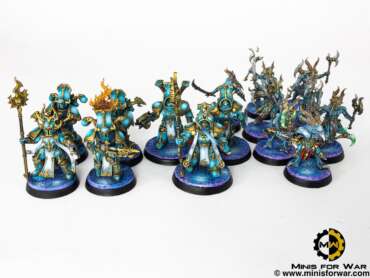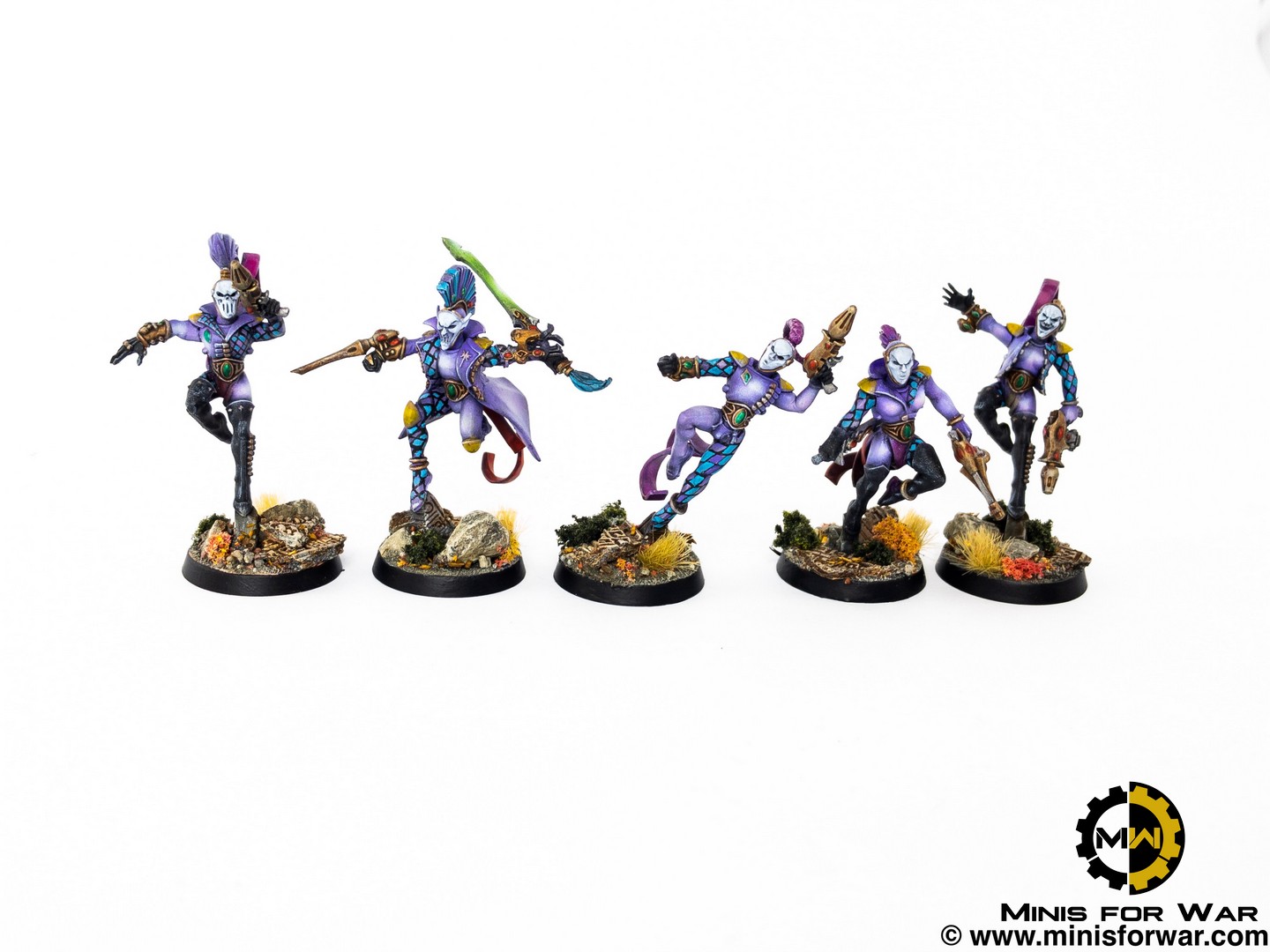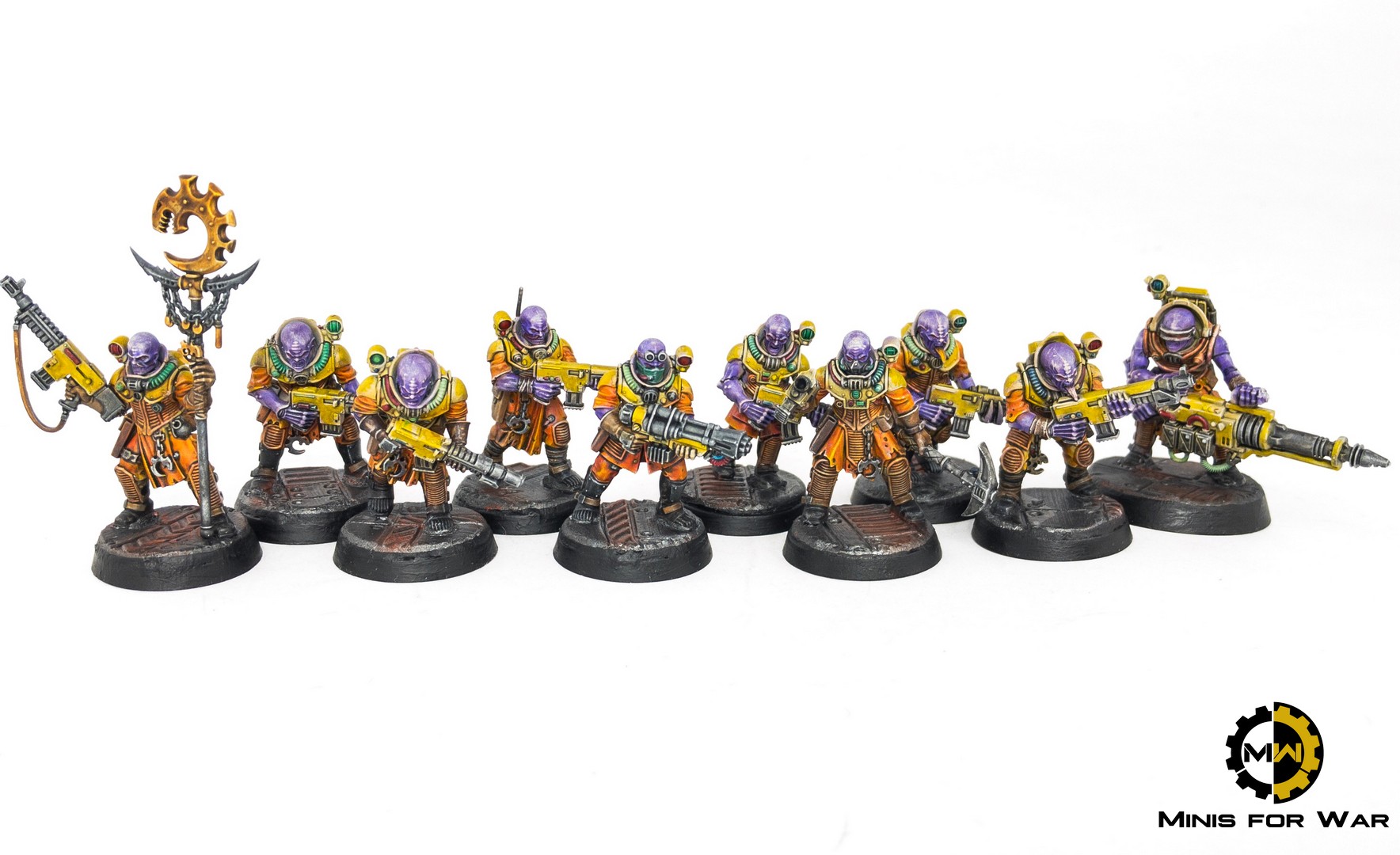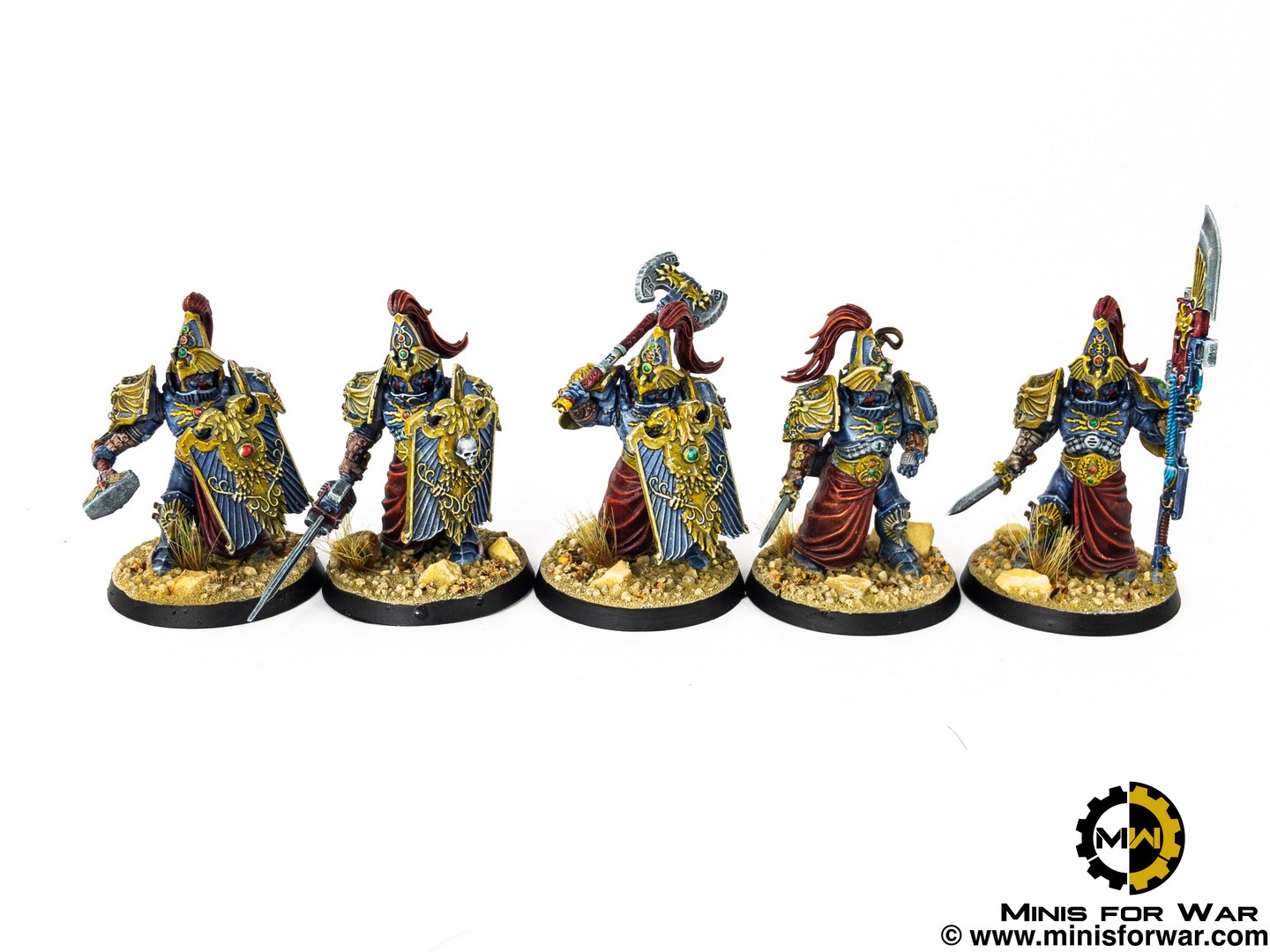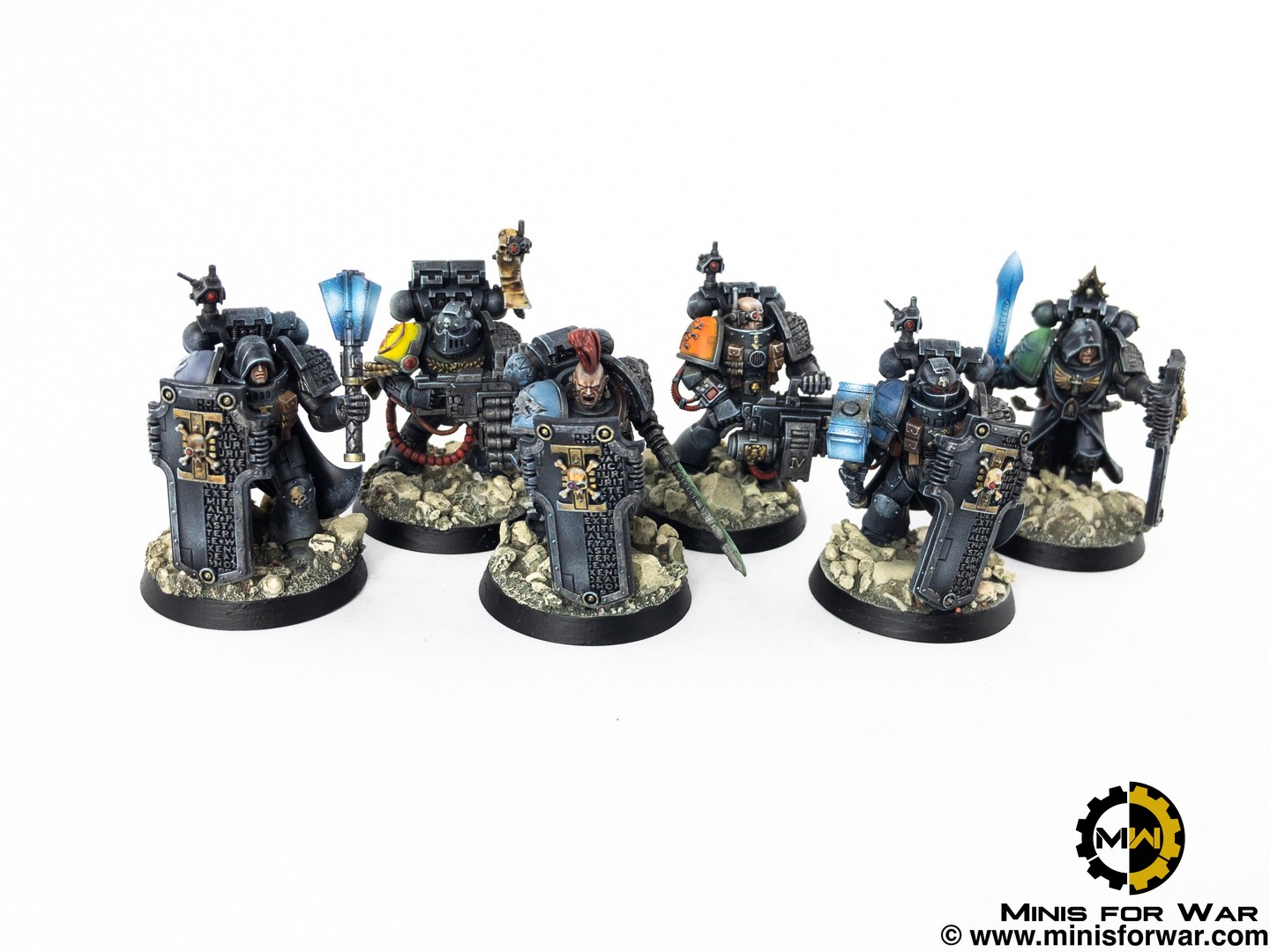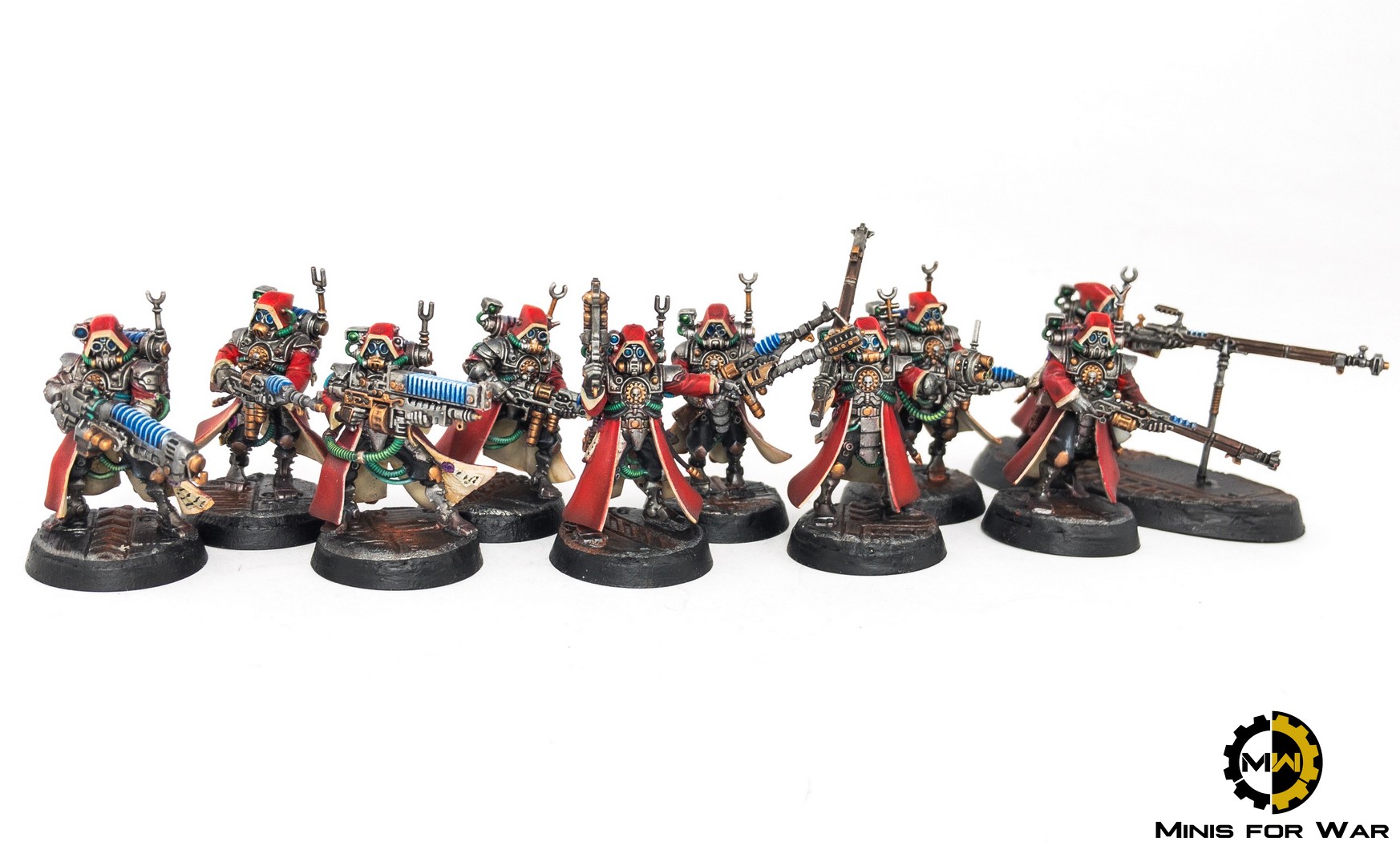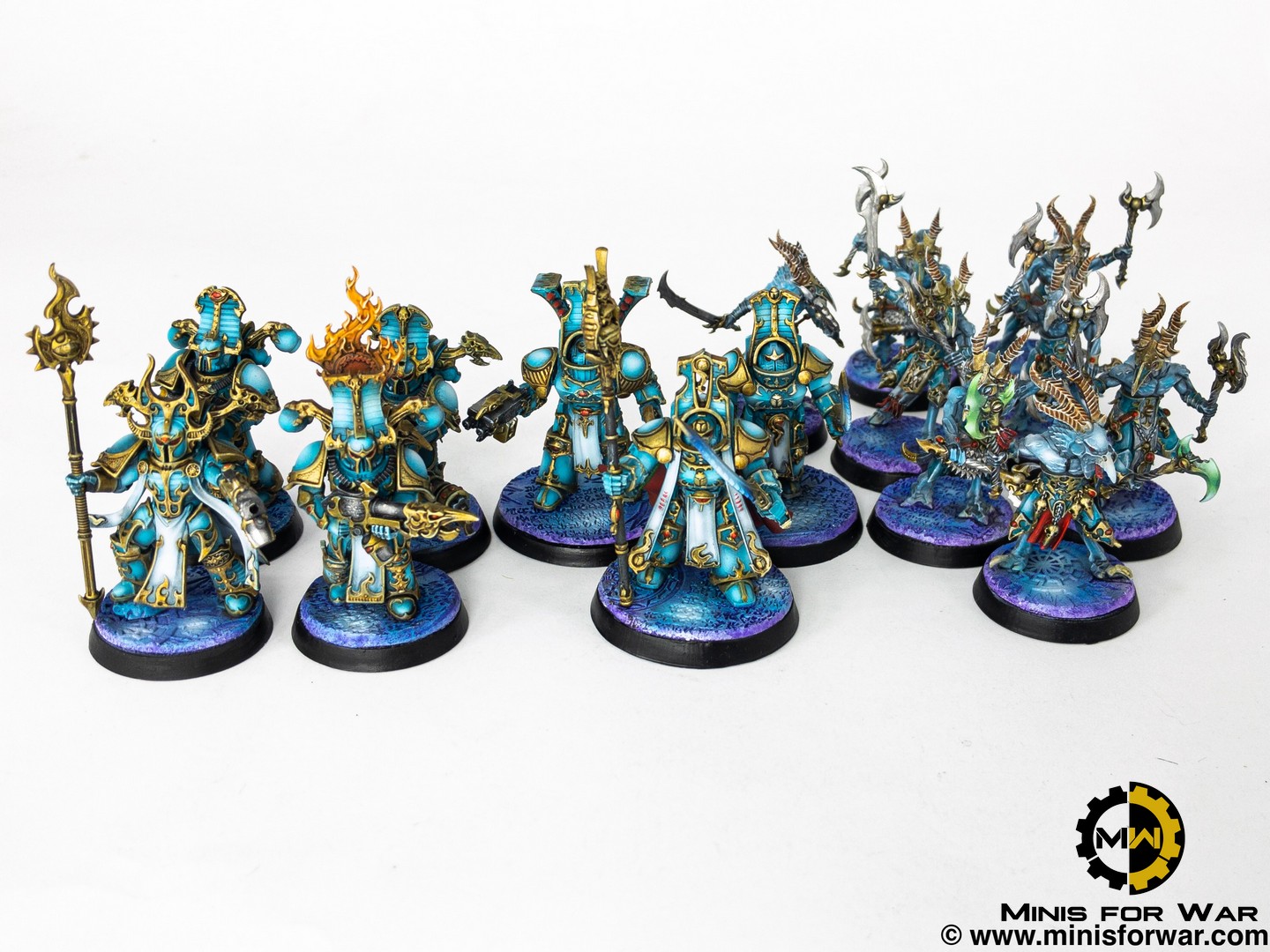
[:pl]
Ciężko precyzyjnie wskazać najpopularniejszą grę figurkową na świecie, ale w każdym rankingu na podium ustawi się legendarny Warhammer 40.000. System ten czerpie siłę z arcyklimatycznego, gotycko-montypythonowskiego uniwersum oraz z modeli, w których pięknie może zakochać się niemal każdy. Świat wykreowany przez GW obrósł przez lata dziesiątkami spin-offów. Mamy więc planszówki, karcianki, gry komputerowe i mobilne, książki, komiksy… Wkrótce ma też powstać serial i kolejny film (po niezbyt udanym “Ultramarines”). Kwestią czasu jest pojawienie się w sprzedaży płatków śniadaniowych z Aquillą…
Czymś co blokuje rozwój popularności “czterdziestki” jest ona sama. Jako gra figurkowa stawia przed nowymi adeptami dużą barierę wejścia. Modele są prześliczne, jednak przygotowanie pełnej armii do grania stanowi spore wyzwanie. Nie chodzi tylko o cenę, ale i ilość pracy jaką nowicjusz będzie musiał włożyć w jej przygotowanie i pomalowanie. Zasady gry mimo ciągłej ewolucji, są nadal złożone. Trzeba poświęcić sporo czasu, by “ogarnąć się” w tych wszystkich regułach, kombinacjach oddziałów i sprzętu. Dodatkowo do rozegrania bitwy potrzebujemy naprawdę sporo przestrzeni (stół 72’x48′ do średnich rozmiarów potyczki). W swej podstawowej wersji Warhammer 40.000 wymaga więc sporego zaangażowania, na które mogą sobie pozwolić tylko najbardziej zdeterminowani fani.
Rozmiar XS
Jeżeli masz ochotę eksterminować Xenosów w imię Boga-Imperatora, ale nie chcesz sprzedawać nerki i rezygnować z oglądania seriali, to od 2018 roku masz taką możliwość. Mam na myśli grę “Kill Team” – to też czterdziestka, ale znacznie bardziej przystępna i grywalna!
Została ona rok wcześniej poprzedzona wydaniem tytułu “Shadow War: Armageddon”. Pierwowzór miał bardzo proste założenia fabularne: małe, elitarne oddziały stają naprzeciw siebie z dala od swych głównych sił. W labiryncie ruin, konstrukcji i nierówności terenu mają do wykonania misję o znaczeniu strategicznym. Nie mogą liczyć na wsparcie artylerii, czołgów ani bohaterów. Pozostaje im tylko przebiegłość, odwaga, dobry plan, przegięta rozpiska i fartowne rzuty. W praktyce gra umożliwia nam złożenie kilku lub kilunastoosobowego oddziału, należącego do popularnych “czterdziestkowych” frakcji i rozegranie skirmishowej potyczki. “Kill Team” oferuje nam w zasadzie to samo, jednak jako gra jest dużo bardziej dopracowany, atrakcyjny i rozbudowany.
Często przygoda z systemem figurkowym zaczyna się od startera. To najszybszy i najbardziej korzystny sposób by odtworzyć na stole fragmenty bitew mrocznej przyszłości. Pod tym względem “Kill Team” nie pozostaje w tyle za konkurencją – w ciągu niespełna dwóch lat funkcjonowania na rynku ukazały się aż trzy różne pudła startowe oraz duży dodatek! W każdym z nich znajdziemy wszystko co niezbędne do rozpoczęcia zabawy – podręcznik, kostki, miarki, figurki, makiety oraz planszę.
Zaskakująco dobrym elementem starterów są tereny – dokładnie wykonane, łatwe w montażu, a w dodatku można je ustawić na wiele różnych sposobów. Wygląd stołu uzpełnia również piękna, zadrukowana na grubej tekturze plansza. Oprócz walorów estetycznych pomaga nam szybciej wyznaczyć środek mapy, podzielić ją na ćwiartki i ułatwia odmierzanie zasięgów ruchu oraz broni (przy czym nie jest podzielona na pola).
Modele w zestawie startowym tworzą dwie grywalne bandy, a w każdej z jego edycji otrzymaliśmy inne frakcje. Śmiałym posunięciem wydawniczym było też stworzenie unikalnych figurek, nie przypisanych do żadnej obecnie wydawanej czterdziestkowej armii – załogę statku handlowego i mutanty z Osnowy (starter “Kill Team: Rogue Trader”). Wszystkie modele zaprojektowano tak, by przyspieszały od zera do setki bicie każdego nerdowskiego serca.
Zabawa w “Kill Team” to klasyczny skirmish. Nasze oddziały będą raczej nieliczne – minimum to trzy modele, a największe hordy (po uwzględnieniu zasad dodatkowych) osiągną liczebność kilkunastu figurek. Będą się one potykać się na niewielkiej powierzchni: 22′ x 30′. Tak mały areał daje nam podwójną korzyść – pole bitwy zmieści się na zwykłym, domowym stole, a do tego akcja od razu rusza z kopyta. Modele praktycznie od momentu rozpoczęcia starcia mają się w zasięgu swoich spluw. Nie ma czasu na kampienie, walka wre już od pierwszej rundy.
Skoro o walce mowa, to w “Kill Team” zastosowano mechanikę znaną nam z “Warhammera 40.000”. Figurki mają kilka parametrów, określających zasięg ich ruchu, skuteczność w walce wręcz i dystansowej, odporność na obrażenia oraz morale. Całe starcie zostało podzielone na tury. Najpierw poruszamy swoje modele, potem strzelamy, czarujemy, a wreszcie przechodzimy do rękoczynów (tzn. nasze figurki przechodzą…). Na koniec tury może zajść potrzeba przetestowania morale.

Oczywiście jak na skirmish przystało, zasady są nieco bardziej szczegółowe – np. nie każda rana oznacza wyłączenie z walki. Da się też przygotować reakcję na działania przeciwnika i wykonać działania w trakcie jego tury. Nie z każdej broni będziemy mogli wystrzelić, jeśli model wykonał ruch. Możliwy jest też spadek morale przy zbyt wysokich stratach – przez co model będzie walczył gorzej niż zwykle. Podstawowe reguły systemu to około 20 stron i mam wrażenie, że można by je jeszcze uprościć (np. obecnie skuteczność ataku rozstrzyga się serią aż trzech rzutów).
Dzięki umiarkowanej skali rozgrywki, gra toczy się bez przykrych dłużyzn. Mała liczba figurek równa się niewielkiej ilości rzutów i liczenia. Nie należą do rzadkości rozgrywki ukończone w kilkadziesiąt minut, jednak zwykle potrzeba nieco ponad godziny na rozegranie scenariusza. Każda minuta jest wypełniona akcją, każdy rzut może zepsuć nawet najlepszy plan. Ponadto dostępne mamy różne tryby zabawy (część z nich pojawia się w dodatkach), które zwielokrotnią frajdę. Możemy grać misje narracyjne, rywalizacyjne, na świeżym powietrzu i w pomieszczeniach (w świecie gry), kampanię, tryb wieloosobowy…
Trochę czasu i partii upłynie, zanim zdołacie zapamiętać wszystkie współczynniki, zasięgi różnych broni, siłę, modyfikatory pancerza. Na szczęście w porównaniu z pełną wersją WH40k, ilość tych zasad nie jest przytłaczająca.
Mobilizacja serc, mobilizacja rąk, mobilizacja portfeli
Warto wiedzieć, że podstawowy podręcznik zawiera zasady potrzebne do wystawienia w grze kilkunastu frakcji znanych z uniwersum Warhammera 40k. W zasadzie możemy zagrać wszystkim oprócz dużych pojazdów i wyspecjalizowanych jednostek Imperium, takich jak Officio Assassinorum czy Sisters of Silence. Skromne liczebnie listy armii sprawiają, że po nabyciu dwóch pudełek piechoty dysponujemy zestawem modeli i części, z których możemy złożyć zróżnicowane rozpiski. To jednak nie wszystko! W ciągu niedługiego przecież żywota, system dorobił się nie tylko starterów, ale również kilku linii dodatków. Mieliśmy bohaterów (do każdej frakcji), książkę z zasadami pozwalającymi na wystawienie jednostek elitarnych, nowe frakcje w “White Dwarfie”, nowe zestawy makiet, suplement do gry turniejowej.
Kuszącą opcją były limitowane (niestety!) pudełka ze specjalnymi drużynami. Oprócz figurek, dostawaliśmy w nich historię danego oddziału, nowe scenariusze, karty ze statystykami oraz sporą ilość wspaniałych makiet – a to wszystko w atrakcyjnej cenie. Teraz trzeba zadowolić się standardowymi pudełkami z figurkami do Warhammera 40k albo przeszukać ofertę niezależnych sklepów internetowych i stacjonarnych.
Oferta którą zaserwowało nam GW sprawia, że bardzo łatwo można wystartować z “Kill Teamem”, a następnie rozbudowywać go zgodnie z naszymi preferencjami i stylem gry. Ponadto niemal pewne jest, że w temacie systemu “Kill Team” Games Workshop nie powiedziało jeszcze ostatniego słowa. Wciąż brak w nim zasad do dużych potworów lub mechów bojowych…
Nawet człowiek który nic nie posiada, może oddać Imperatorowi swoje życie
Pora na rekomendację – czy to jest dobra gra? Jako pasjonat wierzę, że nie ma złych bitewniaków, są tylko źle dopasowane do potrzeb danego gracza. Spróbujmy więc zastanowić się, kogo “Kill Team” zainteresuje. Sądzę że ten tytuł może spodobać się:
– Osobom które kochają świat “Warhammera 40k”, ale do tej pory stroniły od gry ze względu na jej skomplikowanie i koszty.
– Weteranom systemu, którzy mają już kilka armii, ale brakuje im czasu i miejsca na wielogodzinne rozgrywki.
– Pasjonatom chcącym pograć z kimś do tej pory niezaangażowanym w hobby: koleżanką, sąsiadką, współpracowniczką…
– Ludziom którzy chcą spróbować bitewniakowej zabawy, ale nie są przekonani, czy będzie im ona na dłuższą metę odpowiadać. “Kill Team” daje możliwość sprawdzenia tego szybko i niskim kosztem.
– Rodzicom którzy chcą wkręcić w hobby swoje dzieci. Umiarkowana złożoność systemu sprawia, że poradzi sobie z nim większość nastolatków (o ile angielski nie jest dla nich problemem, a nie ma chyba lepszej metody nauki języka obcego niż poprzez zabawę).
– Tym wszystkim, którzy potrzebują pretekstu do kupienia sobie i pomalowania kilku znakomicie wyglądających i zaprojektowanych figurek.
Podsumowanie
Nadal nie jesteście pewni, czy warto bliżej poznać “Kill Team”? Na sam koniec spróbuję wskazać mocne i słabe strony tej gry.
Zalety:
+ Proste do zrozumienia i nauczenia się zasady podstawowe
+ Makiety najwyższej jakości i równie dobre modele
+ Mała skala bitew
+ Szybki czas rozgrywki
+ Znakomita dystrybucja przekładająca się na stosunkowo łatwy dostęp
+ Olbrzymie możliwości rozbudowy i urozmaicenia rozgrywki
+ Rzesza fanów na całym świecie – bez trudu znajdziecie kompanów do gry
Wady:
– Nieco niewygodna mechanika podstawowa
– Duża ilość dostępnych opcji sprawia, że można się poczuć się zagubionym podczas decydowania o zakupach
– Słabe zrównoważenie sił frakcji przy grze turniejowej
Autor: Karol “Gervaz” Siadul
[:en]
It’s hard to pinpoint the most popular figure game in the world, but the legendary Warhammer 40,000 will be placed on the podium in each ranking. This system draws its strength from the grim, heroic universe and from models that almost anyone can fall in love with. The world created by GW has grown dozens of spin-offs for years. We have a board games, card games, computer and mobile games, books, comics … Soon there will be a tv series and another film (after the not very successful “Ultramarines”). A matter of time is the appearance of breakfast cereals with Aquilla…
Something that hinders the development of popularity of “40k” is the game itself. As a miniature wargame, it puts quite a barrier at the entrance for the new players. The models are beautiful however preparing a full army to play is a demanding task. It is not only about the price, but also the amount of work that a newcomer will have to put into preparing and painting an army of models. The rules of the game, despite continuous evolution, are still a bit too complex. You need to spend a lot of time to embrace all these rules, combinations of squads and equipment. In addition, we need a lot of space to play the battle (table 72’x48′ for medium-sized games). In its basic version, Warhammer 40,000 requires a lot of commitment that only the most determined fans can afford.
Size XS
If you feel like exterminating Xenos in the name of God-Emperor, but you do not want to sell your kidney and give up watching TV series, then from 2018 you have such an opportunity. I mean “Kill Team” – it’s also 40k, but much more accessible and fun to play!
It was preceded a year earlier by the release of the title “Shadow War: Armageddon”. The original had very simple plot assumptions: small, elite units face each other away from their main forces. In the maze of ruins, structures and dangerous terrain, they have a mission of strategic importance to perform. They cannot count on the support of artillery, tanks or heroes. All that is left for them is cunning, courage, a good plan, overpowered roster and lucky dice throws. In practice, the game allowed us to assemble a team of several or a dozen or so, belonging to the popular Warhammer 40.000 factions and to play a skirmish battle. “Kill Team” basically offers us the same thing, but as a game it is much more refined, attractive and extended than “Shadow War: Armageddon”.
Often the adventure with the wargaming system begins with a starter set. It’s the fastest and most beneficial way to recreate fragments of battles from the dark future on the table. In this aspect “Kill Team” is not lagging behind the competition – in less than two years of functioning on the market as many as three different starting boxes appeared (and many smaller expansions)! In each of them we will find everything necessary to start the game – a rulebook, dices, rulers, figurines, models and a board.
A surprisingly good element of the starter set are the terrains – carefully made, easy to assemble, and they can be set in many different ways. The appearance of the table is also complemented by a beautiful, printed on thick cardboard board. In addition to aesthetic values, it helps us to quickly determine the center of the map, divide it into quarters, and facilitates measuring ranges of motion and weapons (while it is not divided into squares, like in the “Space Hulk”).
The models in the starter kit form two playable teams, and in each of its editions we have received different factions. A bold publishing move was the creation of unique figurines not assigned to any currently released Warhammer 40k army: the crew of the merchant ship and mutants from Warp (“Kill Team: Rogue Trader”). All models are designed to accelerate from zero to hundreds the beating every nerd heart.
Playing in “Kill Team” is a classic skirmish. Our troops will be rather few – minimum are three models, and the largest hordes (after taking into account additional rules) will reach a number of dozen-and-so figures. They will fight over a small area: 22 ‘x 30’. Such a limited acreage gives us a double advantage – the battlefield will fit on an ordinary home table, and the action immediately starts off. Models have been within range of their guns since the start of the fight. There is no time for hide-and-seek, the fight is booming from the first round.
Speaking of combat, the “Kill Team” uses the mechanics known to us from “Warhammer 40,000”. Figures have several parameters determining their range of motion, effectiveness in melee and ranged combat, resistance to damage and morale. The whole fight was divided into rounds. First, we move our models, then we shoot, cast spells, and finally we go to the melee. At the end of the turn, you may need to test your morale.

Of course, as befits skirmish, the rules are a bit more detailed – e.g. not every wound means exclusion from the fight. You can also prepare a response to your opponent’s actions and react during his turn. Not all weapons will be able to fire if the model has made a move. It is also possible to decrease morale with too high losses – so the model will fight worse than usual. The basic rules of the system are about 20 pages and I have the impression that they could be simplified (e.g. currently, the effectiveness of an attack is decided by a series of three throws).
Thanks to the moderate scale of the game, the game is played without any unpleasant slow-downs. A small number of figures equals a small amount of dice throwing and counting. It is not uncommon for games to be completed in tens of minutes, but usually it takes a little over an hour to play a single scenario. Every minute is filled with action, every roll can ruin even the best plan. In addition, we have different modes of play (some of them appear in the add-ons) that will multiply the fun. We can play narrative, competitive missions, outdoors and indoors (in the game world), campaign, multiplayer …
It takes some time before you can remember all the parameters, ranges of various weapons, strength, armor modifiers. Fortunately, compared to the full version of WH40k, the amount of these rules is not overwhelming.
Mobilization of hearts, mobilization of hands, mobilization of wallets.
It is worth knowing that the basic rulebook contains the rules needed to put in a dozen or so factions known from the Warhammer 40k universe in the game. Actually we can play everything except large vehicles (like Knights) and specialized units of the Empire, such as Officio Assassinorum or Sisters of Silence. The modest army lists mean that after purchasing two infantry boxes, we have a set of models and parts from which we can make various lists. However, this is not all! During the short life, the system was enriched not only by starters, but also by several add-ons lines. We had heroes (for each faction), a book with rules that allow us to list elite units, new factions in “White Dwarf”, new sets of terrain models, a tournament game supplement.
A tempting option were limited (unfortunately!) boxes with special teams. In addition to the figurines, we received in them the history of the given squad, new scenarios, cards with statistics and a large number of great terrains- all at an attractive price. Now you need to settle for standard boxes for Warhammer 40k figurines or search the offer of independent online and stationary stores.
The offer that GW has served us makes it very easy to start with “Kill Team” and then expand it according to our preferences and style of play. In addition, it is almost certain that Games Workshop has not yet said the last word on the “Kill Team” system topic. It still lacks rules for large monsters or mechs…
Even a man who has nothing can give his life to the Emperor.
Time for a recommendation – is this a good game? As a passionate person, I believe that there are no bad wargames, they are only ill-suited to the needs of a given player. Let’s try to think about who will be interested in “Kill Team”. I think this title may appeal to:
– People who love the world of Warhammer 40k, but so far shunned the game because of its complexity and cost.
– Veterans of game who already have several armies, but lack the time and space for hours of play.
– Enthusiasts wanting to play with someone who has not been involved in the hobby so far: a friend, neighbor, colleague…
– People who want to try battle fun but are not convinced that it will suit them in the long run. “Kill Team” gives you the opportunity to check it quickly and at low cost.
– Parents who want to get their children involved in the hobby. The moderate complexity of the game means that most teenagers can handle it (unless English is a problem for them, and there is probably no better way to learn a foreign language than through play).
– To all those who need an excuse to buy and paint some great looking and designed figurines 🙂
Summary
Still not sure, is it worth getting to know “Kill Team” better? Finally, I will try to point out the strengths and weaknesses of this game.
Advantages:
+ Basic rules that are easy to understand and learn
+ Top-quality terrains and equally good models
+ Small scale of battles
+ Fast gameplay time
+ Excellent distribution, which translates into relatively easy access
+ Huge possibilities to expand and diversify the game
+ Crowds of fans around the world – you can easily find companions to play
Disadvantages:
– A bit uncomfortable basic mechanics
– The large number of available options makes you feel lost when deciding about shopping
– Poor balance of faction forces in tournament play
Author: Karol “Gervaz” Siadul
[:]

